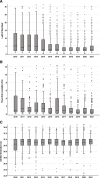Multiprofessional cross-site working between a level 1 and a level 3 neonatal unit: a retrospective cohort study
- PMID: 36645761
- PMCID: PMC9511588
- DOI: 10.1136/bmjpo-2022-001581
Multiprofessional cross-site working between a level 1 and a level 3 neonatal unit: a retrospective cohort study
Abstract
Objective: To assess the association of short-term neonatal outcomes with cross-site working of multiple healthcare professional teams between a level 3 and a level 1 neonatal unit.
Design: Retrospective cohort study.
Setting: A level 1 neonatal unit in London.
Patients: All infants admitted to the neonatal unit, between 2010 and 2021.
Interventions: The clinical service was rearranged in 2014 with the introduction of cross-site working between the level 1 unit and a level 3 unit of neonatal doctors, nurses and allied healthcare professionals.
Main outcome measures: Admission of infants with a temperature less than 36°C, length of stay and time to first consultation by a senior team member.
Results: A total of 4418 infants were admitted during the study period. The percentage of infants delivered at a gestation below 32 weeks was higher in the pre-cross-site period (8.9%) compared with the cross site period (3.6%, p<0.001). The percentage of infants with an Apgar score less than 8 at 10 min was higher in the pre-cross-site period (6.2%) compared with the cross-site period (3.4%, p=0.001). More infants were admitted with a temperature less than 36°C in the pre-cross site period (12.3%) compared with the cross site period (3.7%, p<0.001). The median (IQR) duration of time to first consultation by a senior team member was higher in the pre-cross-site period (1 (0.5-2.6) hours) compared with the cross-site period (0.5 (0.2-1.3) hours) (p<0.001). The median (IQR) length of stay was 4 (2-11) days in the pre-cross-site period and decreased to 2 (1-4) days in the cross-site period (p<0.001).
Conclusions: Cross-site working was associated with lower rates of admission hypothermia, shorter duration of stay and earlier first senior consultation.
Keywords: Neonatology.
© Author(s) (or their employer(s)) 2022. Re-use permitted under CC BY. Published by BMJ.
Conflict of interest statement
Competing interests: None declared.
Figures

References
-
- NHS . Toolkit for high quality neonatal services. London, UK, 2009.
-
- Improvement NEaN . Implementing the recommendations of the neonatal critical care transformation review, 2019.
-
- BAPM . Service standards for hospitals providing neonatal care. 3rd Edition, 2010.
-
- Helenius K, Longford N, Lehtonen L, et al. Association of early postnatal transfer and birth outside a tertiary hospital with mortality and severe brain injury in extremely preterm infants: observational cohort study with propensity score matching. BMJ 2019;367:l5678. 10.1136/bmj.l5678 - DOI - PMC - PubMed
Publication types
MeSH terms
Grants and funding
LinkOut - more resources
Full Text Sources
Medical
